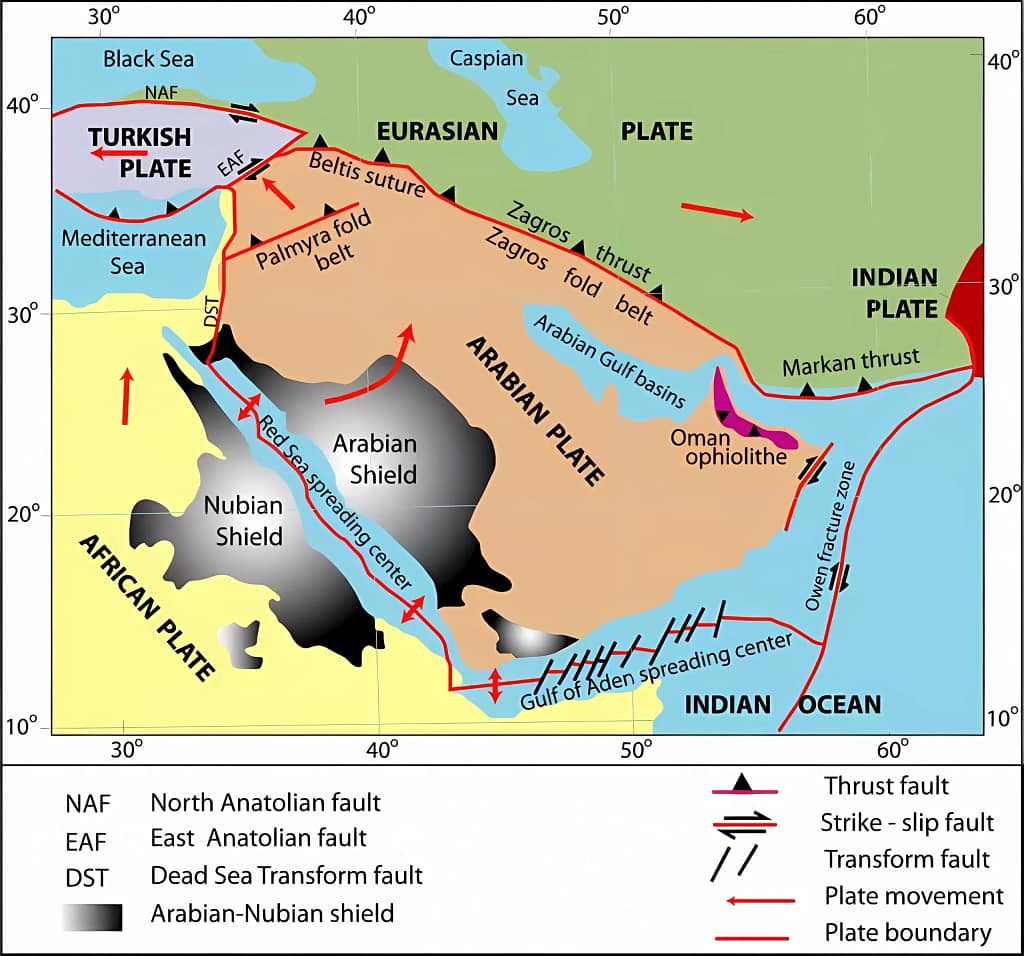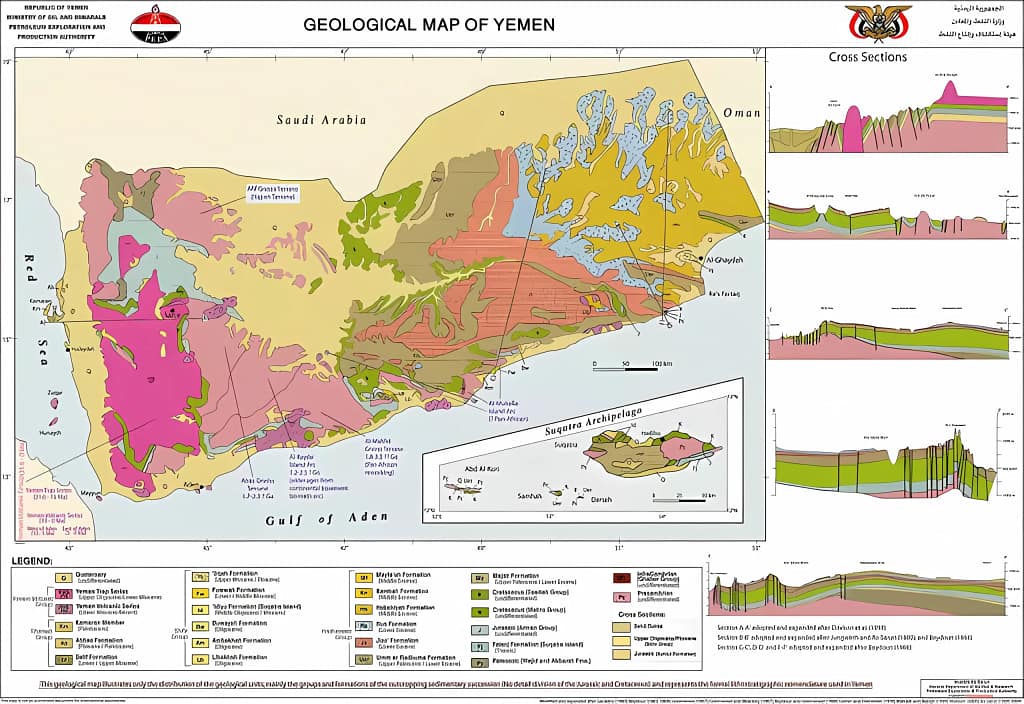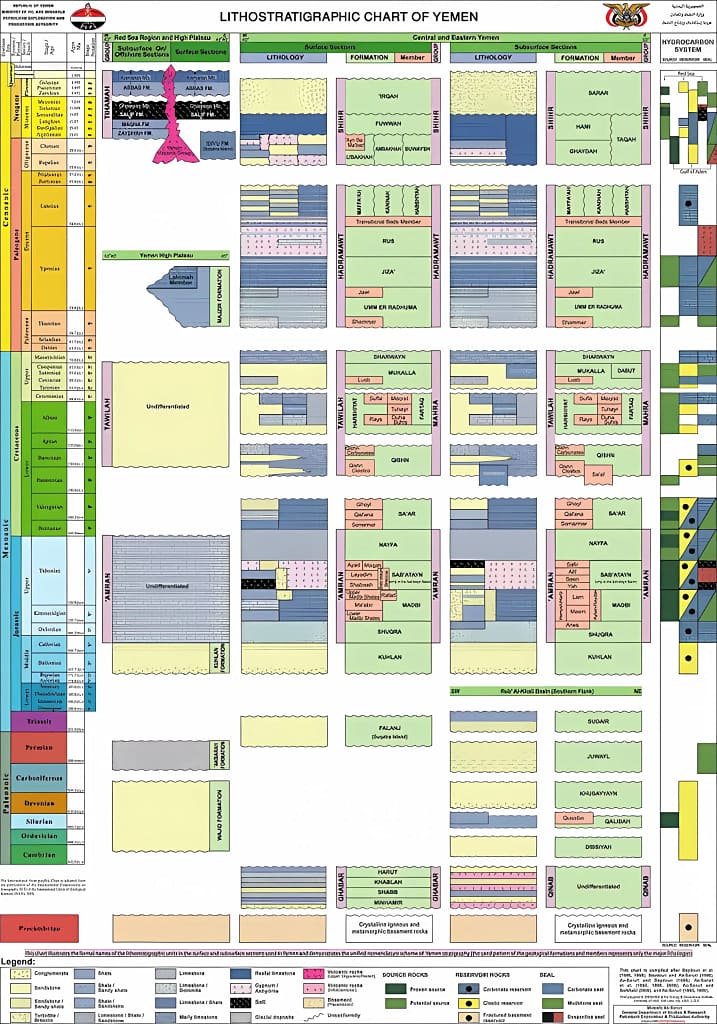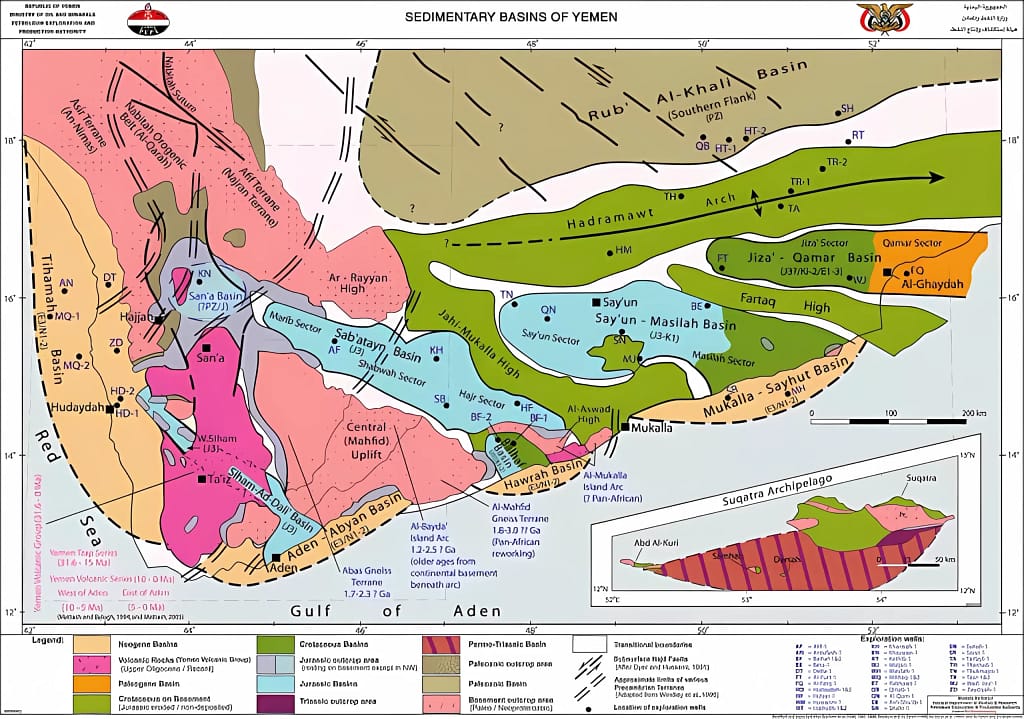Geological & Stratigraphic Settings of Yemen
Geological & Stratigraphic Settings of Yemen
Regional Geology
Geology of Yemen is related to the regional geology of the Arabian Peninsula Fig(1), in which basement complex is a part of the Arabian Shield within a larger geologic framework of the Arabian-Nubian Shield. The later had been developed during the Upper Archian (?) to Neoproterozoic age and formed accreting microplate gneiss terranes and volcanic island arcs (Windley et al. 1996). Therefore:

Figure (1) Arabian Plate
The Basement rocks
The Basement rocks of Yemen represent the southern extension of the Arabian Shield Fig(2), is of Paleoproterozoic to Neoproterozoic age. In Yemen has identified five terranes, which can be correlated with the eastern margin of the Arabian Shield in Saudi Arabia and with northern Somalia. These include Pleoproterozoic to Neoproterozoic gneissic terranes and Pan-African island arc terranes and suture zones. These are the Afif, Abas and Mahfid terranes (gneiss terranes) and Al-Bayda’ and Mukalla terranes (arc terranes). The Basement of Yemen provides the link between the arc collage of the Arabian Shield and the gneissic Mozambique belt of east Africa.
In the Upper Neoproterozoic constitution of the shape of the Arabian plate has commenced, so that in Yemen a transitional stage between the basement and platform was development and evidenced by the deposition of folded sediments of the Ghabar Group (Infracambrian) Fig(2), Fig(3). Similar subsurface Infracambrian deposits are known from Qinab-1 well (southern flank of the Rub’ Al-Khali basin) Fig(4), which are defined formally as Qinab Group Fig(2).

Figure (2) Yemen’s Geological Map
Infracambrian succession Fig(3) is represents by the Ghabar Group Fig(2), which developed only between Wadi Ghabar and Wadi Minhamir areas. The Ghabar Group (InfraCambrian/ ?earliest Paleozoic) Fig(2) is formally divided into four formations (Minhamir, Shabb, Khablah, and Harut Formations). It consists of different sediments (conglomerate, siltstone, sandstones, shales, carbonates) of very low metamorphic degree and rest unconformably on the igneous extrusive Tha’lab Group of Neoproterozoic age and overlain unconformably and with angularity by the Qishn Formation of Early Cretaceous age.

Figure (3) Lithostratigraphic Chart of Yemen

Figure (4) Sedimentary Basins Map
The Paleozoic sediments Fig(3)
The Paleozoic sediments deposit after the accretion Afro-Arabian Plate from parts of the Gondwanan continent. Continental sedimentation and deposition of sandstones, which represent by the Wajid Formation (Cambrian/Carboniferous) and glacial deposits of tillites, shales and drop stones of the Akbarah Formation (Upper Carboniferous/Permian) in the NW of Yemen. Subsurface sections are distributed in the San’a basin as well as in the Sab’atayn basin (Marib sector) Fig(4) by probably thick sequence of the Wajid and ‘Akbarah Formations, whereas in the northern part of Tihamah basin Fig(4), only deposit of the ‘Akbarah Formation was observed.
The Rub’ Al-Khali basin Fig(4) (southern flank) constitutes thick subsurface sedimentary strata of Paleozoic age, and composed of thick clastics and marine sediments represent by the sandstone of the Dibsiyah Formation (Cambrian/Lower Ordovician), the Qalibah Formation, mainly the Qusaiba Member (Lower/Middle Silurian), which represents the excellent source rocks of the Paleozoic deposits; the Khussayyan Formation (Upper Devonian/Lower Carboniferous), which consists of sandstone and the Juwail Formation (Middle Carboniferous/Lower Permian), which consists mainly of sandstone.
The Mesozoic sediments
The Mesozoic sediments started after the regional emergence representing by the Jurassic and Cretaceous successions. Triassic sediments of Falanj Formation crop out only in the south eastern part of the Suqatra Island. Triassic successions of the Sudair Formation only distributed in the subsurface sections in the Rub’ Al-Khali basin Fig(4) (southern flank) that composed of green and red shales.
The Jurassic succession started with continental sediments in the lower part of the Kuhlan Formation on the peneplained basement and on Paleozoic in NW Yemen. First marine sediments deposit of shale and sandy carbonates in the upper part of the Kuhlan Formation, which continued by major transgression with platform development and shallow marine deposits of Shuqra Formation. The upper part of the Shuqra Formation in the subsurface section of the Sab’atayn basin Fig(4) (Marib sector) is formally defined as Arwa Member and composed of deep marine carbonate deposition that can give an evidence of early rifting in the Marib sector.
Initial Rifting in the Lower Kimmeridgian time with the deposition of deep marine sediments in all Mesozoic rift basins, mainly the Siham-Ad-Dali’, the Sab’atayn and the Say’un-Masila basins Fig(4). Continued rifting and coincident sea level rise followed by deposit of deep marine sediments (Lower and Upper Madbi Shales Members), well bedded limestone (Ma’abir Member) and turbidites (Rafad Member) in the margins of the Sab’atayn and Say’un-Masilah basins Fig(4). Isolation of the Sab’atayn basin Fig(4) gives rise to deposition of thick halite (Shabwah Member), bituminous shale (Layadim Member), and gypsum and turbidites (‘Ayad and Maqah Members) of the Sab’atayn Formation. Continuous transgression laid down to deposition of shallow and deep marine sediments of the Nayfa Formation (Upper Tithonian/Lower Berriasian). Subsurface succession of the Madbi Formation in the Sab’atayn basin (Marib sector) Fig(4) represented by the following members, the Meem, Lam, Haniyah, Harib, ‘Ayban and Raydan Members. The Sab’atayn Formation in the Sab’atayn basin (Marib sector) Fig(4) divided into Yah, Seen, Alif and Safir Members. The sediment succession from Shuqra to Nayfa Formations is formally named as ‘Amran Group.
Continuous transgression into the Cretaceous succession in the east and deposit of deep and shallow marine sediments of the Sa’ar Formation (Samarmar and Qalana Members) as well as districted clastics, deltaic development (Ghayl Member) in the upper part of the Sa’ar Formation. The age of the Sa’ar Formation is Middle Berriasian/Lower Valanginian.
After the global sea level fall representing by continental sediments followed by marine transgression in the Hauterivian/Barremian time, which maximum flooding surface reaching the Al-Mahfid uplift and gradual regression representing the Qishn Formation as post rift fill with deposition of open marine carbonates in the east, fluvial deltaic and marine input in the west (Qishn Clastics and Qishn Carbonates Members) followed by sea level fall. In the subsurface section (Al-Furt-1 well) of the Jiza’-Qamar basin (Jiza’ sector) Fig(4) a major subsidence during Hauterivian/Early Barremian times took place and deposition of Sa’af Member, which consists of shale and marl sediments with minor limestone interbeds.
Two major transgressions during the Middle Albian and Cenomanian give rise for interfingering of fluvial, deltaic and marine deposition of the Harshiyat and Fartaq Formations. Dominantly fluvial, deltaic deposition of the Mukalla Formation (Turonian/Campanian) with marine input in the west deposit of Lusb Member (Turonian?/Santonian) and continuous more marine influence in the east, specially in the Jiza’-Qamar basin Fig(4) with the deposition of marine sediments of Dabut Formation (Early Campanian/Early Maastrichtian), which represents the upper part of Mukalla Formation in the subsurface section. The Cretaceous ended by the Maastrichtian transgression and the deposition of limestone and marl of the Sharwayn Formation. Generally, the Cretaceous succession is characterized by continental sediments in the west that formally named Tawilah Group (undifferentiated) Fig(3), by interfingering of continental and marine sediments in the centre represented by the Tawilah Group Fig(3) that divided into Qishn, Harshiyat, and Mukalla Formations, and marine sediments in the east represented by the Mahra Group, which include Qishn, Fartaq, Mukalla, Dabut, and Sharwayn Formations.
The Cenozoic sediments
The Cenozoic sediments is developed as Paleogene and Neogene Sediments and represented by the Hadramawt Group (Upper Paleocene/Middle Eocene) Fig(2), the Shihr Group (Lower Oligocene/Pliocene) Fig(2) and the Tihamah Group (Upper Oligocene/Pleistocene) Fig(2). The Hadramawt Group Fig(2) deposited in the Paleogene time after the regional major transgression in the Upper Paleocene time and continued to the Lower Eocene with the maximum flooding surface reaching Al-Mahfid Uplift and represented by the Umm er Radhuma Formation (Shammar Member at the base and Jawl Member at the top) and Jiza’ Formation. Within the deposition of the Hadramawt Group Fig(2) regression happened during the Lower Eocene and marked by the sabkha deposit of the Rus Formation. This was followed by the Middle Eocene major transgression, which reached Al-Mahfid Uplift give rise to deposit of the Transitional Beds Member but with continuous gradual regression to the east laid down a lateral facies changes of the equivalent formations (the Mayfa’ah, the Kaninah and the Habshiyah Formations) before the regional Middle Eocene unconformity caused by the regional uplift of much of Arabia between the uppermost Middle Eocene and Lower Oligocene.
The riftoginous major deposition related to the Gulf of Aden and the Red Sea rifting and represented by the thick sediments of the Shihr and Tihamah Groups Fig(2).
The Shihr Group (Oligocene/Pliocene) Fig(2) is formed by the syn- and post-rift sedimentary successions along the Gulf of Aden Yemeni side including the Libakhah, Ambakhah and Buwaysh Formations (Oligocene), the Fuwwah Formation (Lower/Middle Miocene), and the Irqah Formation (Upper Miocene/Pliocene). Subsurface offshore deposits mainly in the MUKALLA-SAYHUT basin Fig(4) include the Ghaydah Formation (Oligocene/Lower Miocene), Hami Formation (Lower/Middle Miocene), and the Sarar Formation (Upper Miocene/Recent). The Taqah Formation is developed in Jiza’-Qamar basin Fig(4) as equivalent of Ghaydah and Hami Formations (As-Saruri and Beydoun, 1998 and As-Saruri, 1999).
Accordingly, in the Gulf of Aden marine incrusions into coastal embayment gave rise to heterogeneous deposits of the Shihr Group Fig(2) of Oligocene-Pliocene age; offshore, in the subsiding sectors of the rift, thick clastics were being poured in, which were of turbidite nature. Onshore, the Shihr Group Fig(2) deposits reflect disconnected basin Fig(4) deposition and facies are provenance and environment-dependant, whereas offshore, more uniform clastic deposition with occasional shoal carbonates prevail (As-Saruri & Langbein, 1996; As-Saruri and Beydoun, 1998). Initially, marginal marine to restricted evaporitic deposition characterized the Lower Oligocene deposits, to be followed in the Middle Oligocene by major depending and rapid syn-rift marine clastics depositions (Hughes et al., 1991).
The Tihamah Group (Upper Oligocene/recent) Fig(2) represents the syn- and post-rift sediments in the Tihamah basin Fig(4) on- and offshore of the Red Sea along the Yemeni coast and includes the Zaydiyah Formation (Lower Miocene), Maqna Formation (Lower/Middle Miocene), Salif Formation (Middle/Upper Miocene) and Abbas Formation (Pliocene/Pleistocene), which represent the top unit of the Tihamah Group (As-Saruri, 1999; and As-Saruri and Beydoun, 1998).
However, the development of the Red Sea- Gulf of Aden rifts in Oligocene/Recent time, which resulted in massive uplift along the rift boundaries, where huge bimodal volcanic rocks and their associated Neogene intrusions (granite, syenite, diorite, gabbro) formed the high plateau of the western Yemen province.
The Yemen Volcanic Group Fig(2)
Includes all the Cenozoic volcanic rocks, which is divided into the Yemen Trap Series (31.6 – 15 Ma) that consists of thick series of mainly flood volcanic rocks and Yemen Volcanic Series (10 – 0 Ma) that represents thinner series of mainly peralkaline intraplate basaltic volcanic rocks (Mattash and Balog, 1994). The Yemen Volcanic Series is divided into older volcanic rocks intruded west of Aden (10 – 5 Ma) and younger volcanic rocks east of Aden (5 – 0 Ma).
